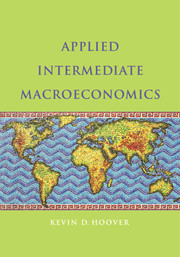Book contents
- Frontmatter
- Brief Contents
- Contents
- Acknowledgments
- To the Student
- To the Teacher
- Part I Introduction
- Part II The National Accounts
- Part III Trends and Cycles
- Part IV Financial Markets
- Part V Aggregate Supply
- Part VI Aggregate Demand
- Part VII Macroeconomic Dynamics
- 15 The Dynamics of Output, Unemployment, and Inflation
- Part VIII Macroeconomic Policy
- Part IX Macroeconomic Data
- Symbols
- Glossary
- Guide to Online Resources
- Index
- References
15 - The Dynamics of Output, Unemployment, and Inflation
from Part VII - Macroeconomic Dynamics
Published online by Cambridge University Press: 05 June 2012
- Frontmatter
- Brief Contents
- Contents
- Acknowledgments
- To the Student
- To the Teacher
- Part I Introduction
- Part II The National Accounts
- Part III Trends and Cycles
- Part IV Financial Markets
- Part V Aggregate Supply
- Part VI Aggregate Demand
- Part VII Macroeconomic Dynamics
- 15 The Dynamics of Output, Unemployment, and Inflation
- Part VIII Macroeconomic Policy
- Part IX Macroeconomic Data
- Symbols
- Glossary
- Guide to Online Resources
- Index
- References
Summary
We judge the economy – as we judge many areas of life – as much by how it is changing as by its current state. We want to know whether GDP, unemployment, and inflation are rising or falling, not just whether they are high or low. In this chapter we examine what determines whether the key variables – unemployment, output, and inflation – are rising or falling at different stages of the business cycle. In earlier chapters, we examined aggregate demand and supply separately. Here we consider how they work together to change output, unemployment, and inflation.
The Interaction of Aggregate Supply and Aggregate Demand
An easy way to distinguish supply factors from demand factors starts with the definition of output scaled by potential output ( scaled output ) developed in Chapter 9 (section 9.5.2): $\skew2\widetilde Y = \frac{Y}{{Y^{pot}}}$. The theory of growth – that is, the theory of aggregate supply in the long run – is really a theory of the development of potential output. The theory of aggregate demand is a theory of output relative to potential. A pure aggregate-supply factor can therefore be thought of as one that changes potential output while holding scaled output ($\skew2\widetilde Y$) constant. A pure aggregate-demand factor can be thought of as one that changes scaled output while holding potential output constant.
Although actual economic factors often mix supply and demand aspects, let us first look at the pure cases.
- Type
- Chapter
- Information
- Applied Intermediate Macroeconomics , pp. 583 - 618Publisher: Cambridge University PressPrint publication year: 2011



